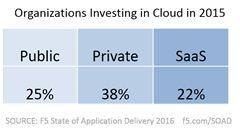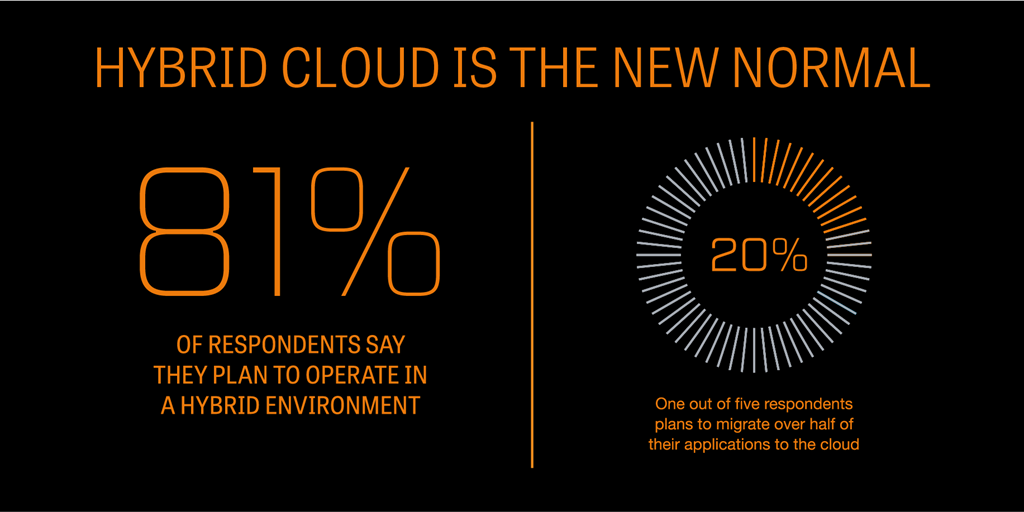Estado de la entrega de aplicación 2016: Un pronóstico muy nublado
Nube. Hoy en día no puedes ir a ningún lado sin ver algo relacionado con la nube. Incluso mi hijo de ocho años lo sabe todo sobre esto. Es donde pone todo el material en su iPod cuando se queda sin espacio local, ¿lo sabías?
Pero más allá del uso a veces inapropiado del término en aplicaciones, anuncios y marketing, la nube es una realidad para todas las organizaciones hoy en día. Para complicar las cosas está la realidad paralela de que las instalaciones locales tampoco van a desaparecer. Así fue como llegamos a la conclusión de que “lo híbrido es la nueva normalidad” en nuestro informe Estado de la entrega de aplicación de 2016.
Ahora podemos discutir sobre la definición de “híbrido” y si es más apropiado decir “multinube” cuando no estamos hablando de arquitecturas de aplicaciones que abarcan múltiples proveedores de nube o si el término “híbrido” tiene más significado que “nube” hace unos seis años. Independientemente de cómo queramos llamarlo, es un hecho que hoy en día las organizaciones emplean una combinación saludable de IaaS, SaaS y entornos locales tradicionales para brindar aplicaciones que respalden los objetivos de productividad y ganancias del negocio. De hecho, solo el 19 % de los encuestados afirma que no está planeando un entorno híbrido y mixto, y el 67 % nos dice que su organización prioriza la nube.

Esto es más que sólo castillos en el aire. Cuando analizamos el gasto de las organizaciones en 2015, la nube privada y SaaS estuvieron entre los cinco primeros, con la nube privada a la cabeza. Sólo el sector móvil logró igualar esa cifra: un 38 % gastó parte de su presupuesto limitado en tecnología.
Y con la distribución de aplicaciones en entornos tan variados surgen desafíos, especialmente aquellos relacionados con la seguridad. Un sorprendente 22% de los encuestados nos dijo que no tenían desafíos con la nube híbrida. Si usted es uno de ese 22%, supongo que la mayoría de las organizaciones que indicaron análisis exhaustivos (29%), gestión de acceso (29%) y seguridad de datos (17%) querrían que divulgara sus secretos.
Aun así, las organizaciones parecen estar abordando los desafíos que la mayoría enfrenta con los entornos híbridos. Los servicios de aplicaciones de más rápido crecimiento (aquellos que las organizaciones planean implementar en los próximos 12 meses) están todos vinculados o son útiles para la implementación de entornos híbridos y de nube.

En el primer puesto, empatados con DNSSEC (26 %) se encontraban los servicios de federación de identidad (26 %). Estos servicios de aplicaciones son invaluables para las organizaciones que necesitan controlar el acceso a aplicaciones implementadas en la nube y, en particular, a las aplicaciones SaaS. La gran ventaja aquí es que la mayoría de los servicios de federación de identificación pueden soportar aplicaciones locales (tradicionales y en la nube) y externas (en la nube y SaaS), ofreciendo claramente una respuesta al desafío integral de identidad y acceso citado por los encuestados con respecto a la nube híbrida. De manera similar, las intenciones del 24% de implementar servicios SSO apuntan al deseo de las organizaciones (y los consumidores) de literalmente controlar la gestión de la identidad en el creciente número de aplicaciones a las que los empleados necesitan acceder todos los días, tanto en las instalaciones como en la nube.
Pero no son solo los servicios de seguridad y de aplicaciones los que se ven afectados por la niebla de la nube que desciende sobre las organizaciones. La relevancia de SDN y DevOps también parece estar ligada a la visión estratégica que tienen las organizaciones sobre la nube, y si es pública o privada.
Encontramos un vínculo mucho más fuerte entre aquellos que consideran que la nube privada es estratégica y calificaciones similares para DevOps que para la nube pública. Lo cual, a primera vista, parece desafiar el deseo del mercado de unir la nube pública y DevOps. Pero dado que una nube privada debe construirse desde cero e incluir la automatización de todo, desde la capa 2 hasta la capa 7, esta relación no es tan descabellada como parece a primera vista. DevOps es definitivamente una de las maneras en que una organización puede construir y sostener el modelo operativo eficiente y ágil que necesita para respaldar algo tan orientado al “servicio” como una nube privada.
En cualquier caso, la distribución de aplicación ciertamente se está volviendo muy confusa dado que hoy en día las aplicaciones se implementan en y desde una multitud de entornos y ubicaciones de nube, todos con distintos grados de visibilidad y control con los que TI puede administrarlos y los servicios que los entregan y protegen.
Para obtener más detalles, no olvide consultar el informe completo sobre el estado de la entrega de aplicación de 2016.
